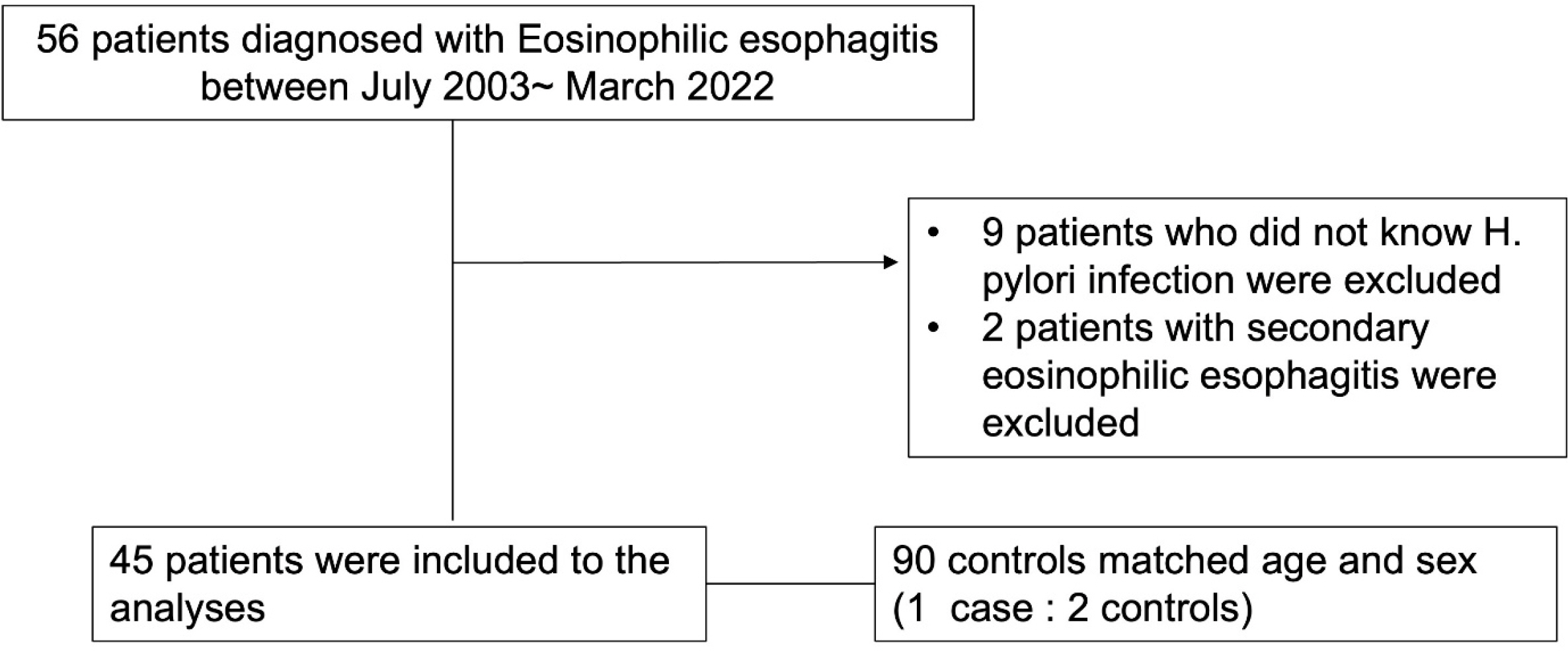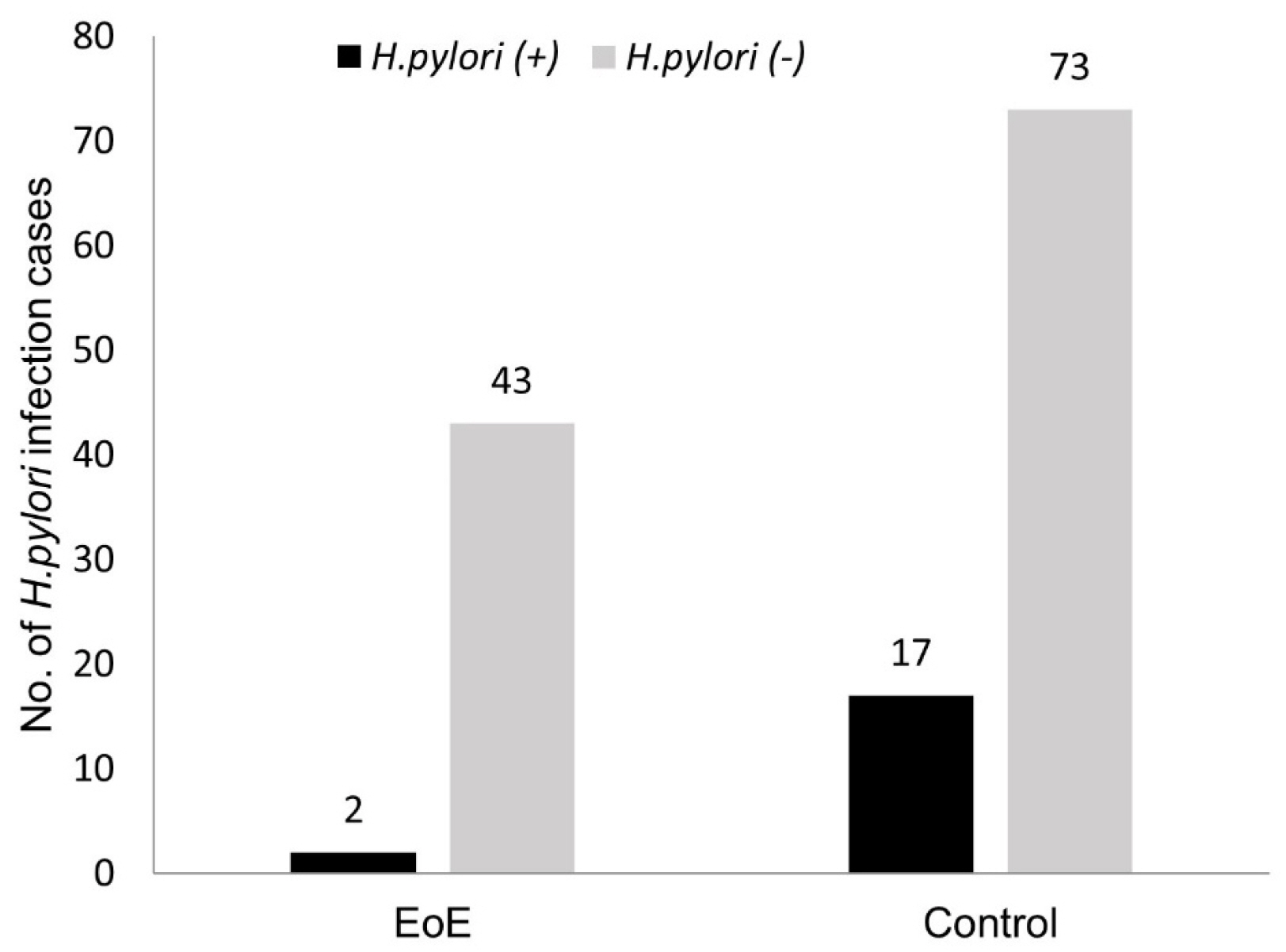Korean J Gastroenterol.
2023 Sep;82(3):122-126. 10.4166/kjg.2023.037.
Association between Helicobacter pylori Infection and Eosinophilic Esophagitis
- Affiliations
-
- 1Department of Internal Medicine, Seoul National University Bundang Hospital, Seongnam, Korea
- KMID: 2546513
- DOI: http://doi.org/10.4166/kjg.2023.037
Abstract
- Background/Aims
This study examined the association between eosinophilic esophagitis (EoE) and Helicobacter pylori (H. pylori) infection.
Methods
A single tertiary referral center case-control study was performed. EoE patients diagnosed at Seoul National University Bundang Hospital from July 2003 to March 2022 were reviewed retrospectively. Forty-five EoE patients were included in the analysis. For each EoE patient, two age and sex-matched normal controls were selected randomly from an outpatient population who received upper gastrointestinal endoscopy.
Results
Although 17 out of 90 (18.9%) controls had a H. pylori infection, only two out of 45 (4.4%) EoE patients showed evidence of a H. pylori infection. EoE was inversely associated with a H. pylori infection (odds ratio 0.20, 95% confidence interval 0.04–0.91, p=0.044).
Conclusions
An inverse association was observed between H. pylori infection and EoE. Further prospective studies will be needed to validate the protective effects of H. pylori infection for EoE.
Figure
Reference
-
1. Muir A, Falk GW. 2021; Eosinophilic esophagitis: A review. JAMA. 326:1310–1318. DOI: 10.1001/jama.2021.14920. PMID: 34609446. PMCID: PMC9045493.2. Hooi JKY, Lai WY, Ng WK, et al. 2017; Global prevalence of Helicobacter pylori infection: Systematic review and meta-analysis. Gastroenterology. 153:420–429. DOI: 10.1053/j.gastro.2017.04.022. PMID: 28456631.3. Hirano I, Furuta GT. 2020; Approaches and challenges to management of pediatric and adult patients with eosinophilic esophagitis. Gastroenterology. 158:840–851. DOI: 10.1053/j.gastro.2019.09.052. PMID: 31836530. PMCID: PMC8063595.4. Lim SH, Kim N, Kwon JW, et al. 2018; Trends in the seroprevalence of Helicobacter pylori infection and its putative eradication rate over 18 years in Korea: A cross-sectional nationwide multicenter study. PLoS One. 13:e0204762. DOI: 10.1371/journal.pone.0204762. PMID: 30332428. PMCID: PMC6192591.5. Kim GH, Park YS, Jung KW, et al. 2019; An increasing trend of eosinophilic esophagitis in Korea and the clinical implication of the biomarkers to determine disease activity and treatment response in eosinophilic esophagitis. J Neurogastroenterol Motil. 25:525–533. DOI: 10.5056/jnm19066. PMID: 31587544. PMCID: PMC6786448.6. Kim GH, Jung KW, Jung HY, et al. 2018; Diagnostic trends and clinical characteristics of eosinophilic esophagitis: A Korean, single-center database study. J Neurogastroenterol Motil. 24:248–254. DOI: 10.5056/jnm17047. PMID: 29605980. PMCID: PMC5885724.7. Dellon ES, Liacouras CA, Molina-Infante J, et al. 2018; Updated international consensus diagnostic criteria for eosinophilic esophagitis: Proceedings of the AGREE conference. Gastroenterology. 155:1022–1033.e10.8. Hirano I, Moy N, Heckman MG, Thomas CS, Gonsalves N, Achem SR. 2013; Endoscopic assessment of the oesophageal features of eosinophilic oesophagitis: validation of a novel classification and grading system. Gut. 62:489–495. DOI: 10.1136/gutjnl-2011-301817. PMID: 22619364.9. Renz H, Blümer N, Virna S, Sel S, Garn H. 2006; The immunological basis of the hygiene hypothesis. Chem Immunol Allergy. 91:30–48. DOI: 10.1159/000090228. PMID: 16354947.10. Bagheri N, Salimzadeh L, Shirzad H. 2018; The role of T helper 1-cell response in Helicobacter pylori-infection. Microb Pathog. 123:1–8. DOI: 10.1016/j.micpath.2018.06.033. PMID: 29936093.11. Doulberis M, Kountouras J, Rogler G. 2020; Reconsidering the "protective" hypothesis of Helicobacter pylori infection in eosinophilic esophagitis. Ann N Y Acad Sci. 1481:59–71. DOI: 10.1111/nyas.14449. PMID: 32770542.12. Shah SC, Tepler A, Peek RM Jr, Colombel JF, Hirano I, Narula N. 2019; Association between Helicobacter pylori exposure and decreased odds of eosinophilic esophagitis-a systematic review and meta-analysis. Clin Gastroenterol Hepatol. 17:2185–2198. e3. DOI: 10.1016/j.cgh.2019.01.013. PMID: 30659992. PMCID: PMC7354099.13. Cheung KM, Oliver MR, Cameron DJ, Catto-Smith AG, Chow CW. 2003; Esophageal eosinophilia in children with dysphagia. J Pediatr Gastroenterol Nutr. 37:498–503. DOI: 10.1097/00005176-200310000-00018. PMID: 14508223.14. Dellon ES, Peery AF, Shaheen NJ, et al. 2011; Inverse association of esophageal eosinophilia with Helicobacter pylori based on analysis of a US pathology database. Gastroenterology. 141:1586–1592. DOI: 10.1053/j.gastro.2011.06.081. PMID: 21762663. PMCID: PMC3202656.15. Furuta K, Adachi K, Aimi M, et al. 2013; Case-control study of association of eosinophilic gastrointestinal disorders with Helicobacter pylori infection in Japan. J Clin Biochem Nutr. 53:60–62. DOI: 10.3164/jcbn.13-15. PMID: 23874072. PMCID: PMC3705158.16. Elitsur Y, Alrazzak BA, Preston D, Demetieva Y. 2014; Does Helicobacter pylori protect against eosinophilic esophagitis in children? Helicobacter. 19:367–371. DOI: 10.1111/hel.12129. PMID: 24750254.17. von Arnim U, Wex T, Link A, et al. 2016; Helicobacter pylori infection is associated with a reduced risk of developing eosinophilic oesophagitis. Aliment Pharmacol Ther. 43:825–830. DOI: 10.1111/apt.13560. PMID: 26898731.18. Molina-Infante J, Gutierrez-Junquera C, Savarino E, et al. 2018; Helicobacter pylori infection does not protect against eosinophilic esophagitis: results from a large multicenter case-control study. Am J Gastroenterol. 113:972–979. DOI: 10.1038/s41395-018-0035-6.
- Full Text Links
- Actions
-
Cited
- CITED
-
- Close
- Share
- Similar articles
-
- Helicobacter pylori and Gastroesophageal Reflux Disease
- The Role of Helicobacter Pylori Infection in Reflux Esophagitis
- Reflux Esophagitis after Cure of Helicobacter pylori Infection: Report of two cases
- A Case of Resolution of Chronic Duodenal Obstruction Showing Newly Developed Reflux Esophagitis after the Eradication of Helicobacter pylori Infection
- Helicobacter pylori Has an Inverse Relationship With Severity of Reflux Esophagitis



